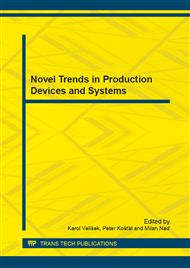[1]
G. Chryssolouris, Manufacturing Systems: Theory and Practice, 2nd Edition 606p, New York, (2005).
Google Scholar
[2]
F. Klocke, S. Gierlings, M. Brockmann, C. Sage, D. Veselovac, Adaptive Control of Manufacturing Processes for a New Generation of Jet Engine Components, 7th CIRP-ICME. (2010) 321.
Google Scholar
[3]
M. Eckstein, Process Monitoring – Ein innovativer Ansatz zur Steigerung der Zuverlässigkeit höchstbelasteter Bauteile der Fluggasturbine, Deutscher Luft- u. Raumfahrtkongress. (2004) Jahrbuch.
Google Scholar
[4]
P.G. Benardos, G.C. Vosniakos, Predicting surface roughness in machining: a review, Int. Jour. of Mach. Tool and Manuf. 43 (2003) 833–844.
DOI: 10.1016/s0890-6955(03)00059-2
Google Scholar
[5]
M. Gunay, E. Yucel, Application of Taguchi method for determining optimum surface roughness in turning of high-alloy white cast iron, Measurement. 46 (2013) 913–919.
DOI: 10.1016/j.measurement.2012.10.013
Google Scholar
[6]
H. Oktem, T. Erzurumlu, F. Erzincanli, Prediction of minimum surface roughness in end milling mold parts using neural network and genetic algorithm, Mat. and Desig. 27 (2006) 735–744.
DOI: 10.1016/j.matdes.2005.01.010
Google Scholar
[7]
J. Paulo Davim, V. N. Gaitonde, S. R. Karnik, Investigation into the effect of cutting conditions on surface roughness in turning of free machining steel by ANN models, J. of Mat. Proces. Tech. 205 (2008) 16–23.
DOI: 10.1016/j.jmatprotec.2007.11.082
Google Scholar
[8]
E. D. Kirby, J. C. Chen, J. Z. Zhang, Development of a fuzzy-nets-based in-process surface roughness adaptive control system in turning operations, Ex. Sys. with Applic. 30 (2006) 529–604.
DOI: 10.1016/j.eswa.2005.07.005
Google Scholar
[9]
F. J. Pontes, A. P. de Paiva, P. P. Belastrassi, J. R. Ferreira, Optimization of Radial Basis Function neural network employed for prediction of surface roughness in hard turning process using Taguchi´s orthogonal arrays, Ex. Sys. with Applic. 39 (2012).
DOI: 10.1016/j.eswa.2012.01.058
Google Scholar
[10]
I. Asilturk, M. Cunkas, Modeling and prediction of surface roughness in turning operations using artificial neural network and multiple regression method, Ex. Sys. with Applic. 38 (2011) 5826–5832.
DOI: 10.1016/j.eswa.2010.11.041
Google Scholar
[11]
V. Upadhyay, P. K. Jain, N. K. Mehta, In-process prediction of surface roughness in turning of Ti-6Al-4V alloy using cutting parameters and vibration signals, Measurement. 46 (2013) 154–160.
DOI: 10.1016/j.measurement.2012.06.002
Google Scholar
[12]
A. Popa, G. Dessein, M. Baili, V. Dutilh, Investigation of Tool Failure Modes and Machining Disturbances Using Monitoring Signals, Int. Jour. of Adv. Mat. Research. 423 (2012) 128-142.
DOI: 10.4028/www.scientific.net/amr.423.128
Google Scholar
[13]
I. Maňková, M. Vrabeľ, P. Kovač, Artificial neural network application for surface roughness prediction when drilling nickel based alloy, Manuf. Technology. 13 (2013) 193-199.
DOI: 10.21062/ujep/x.2013/a/1213-2489/mt/13/2/193
Google Scholar


